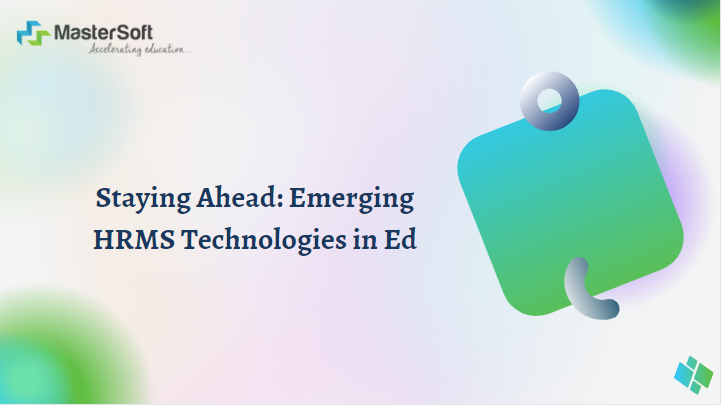Staying Ahead: Emerging HRMS Technologies in Ed

Organizations are increasingly adopting HRMS solutions to simplify HR operations and undergo digital transformation. These systems automate tasks, boost efficiency, and integrate data management with analytics. Additionally, they provide self-service access, help staff members, and encourage increased satisfaction and engagement.
Adopting HRMS solutions with a leave management system is a strategic move to enhance workforce management. It is carried out in a more digital, efficient, and organized manner.
This blog explores the most recent developments in HRMS. It provides real-world examples of how businesses can use HRMS to improve their HR procedures.
It gives examples from the real world showing how HRMS and leave management systems can be implemented effectively. It allows easy HR procedures for increased productivity.
What Is HRMS?
An HRMS, or human resources management system, is a comprehensive suite of software applications designed to manage human resources. It refers to processes that take place throughout an employee’s lifecycle. Employers can ensure compliance with changing labor and tax laws. They gain a thorough understanding of their workforce with its assistance.
An HRMS benefits multiple departments. It is primarily used by HR leaders and staff for daily workforce operations and compliance reporting. It empowers managers and employees through self-service functionalities, particularly appealing to younger hires.
Executives extract workforce trend data and analyze its effects on business operations using an HRMS.
The integration of HRMS with accounting systems is extremely helpful for finance teams. HR-related expenses account for a considerable amount of a company’s expenses. Leading providers offer advanced features beyond basic accounting and provide finance teams with enhanced financial insights derived from HR data.
HRMS: Functions
When choosing the right HRMS for your company, it’s essential to consider functional components. Modern systems typically cover seven key areas, each with varying levels of focus.
-
Candidate Management
It involves handling employment offers and promoting your brand to potential candidates. Additionally, provide a positive candidate experience from application to onboarding.
-
Employee Engagement
It focuses on how employees connect with leadership and colleagues. This improves training, skill development, career paths, recognition, and mentorship through the HRMS.
-
Employee Management
Often referred to as “core HR,” this function supports analysis, reporting, and compliance. It organizes the workforce, defines reporting relationships, and is crucial for employee self-service, reporting, and HR service delivery.
-
Optimization
Using HRMS data creates a workforce vision for the future that will increase engagement. This helps retain top talent and be more resilient to change.
-
Payroll
Its primary function is to calculate earnings, manage deductions, and automate tax filing. Self-service options allow employees to make changes without HR assistance.
-
Workforce Management
It involves tracking employee development, evaluations, disciplinary actions, time and attendance, compensation planning, performance management, and incident recording.
-
Contingent Workforce Management
This function is critical for companies with part-time or temporary employees. It keeps track of specialized skills, community initiatives, and the costs of contingent workers who are not eligible for benefits.
Why Implement HRMS?
An HRMS brings several benefits to a company, simplifies HR tasks, and enhances overall efficiency.
-
Centralized Information
HRMS keeps all workforce data in one place, reduces compliance risks, and provides a comprehensive view for better decision-making.
-
Deeper Insights
With HRMS, companies can analyze workforce costs, identify skills gaps, and address potential issues early. This enhances workforce planning and analytics.
-
Employee Engagement
HRMS helps in talent development by creating training plans, personalized learning paths, and mentorship programs. This contributes to improved employee satisfaction and loyalty.
-
Process Efficiency & Self-Service Culture
HRMS eases HR tasks and allows employees and managers to access their records and find answers to common queries. Automated approval workflows reduce processing time and enhance accuracy.
-
Lower Back-End Overhead
HRMS, especially in a cloud-based model, minimizes IT and capital expenses. It requires less hardware and support resources and improves user satisfaction.
-
Faster Recruiting
HRMS connects recruiters and candidates electronically. It improves the candidate experience through job boards and mobile applications, accelerating the recruiting process and enhancing the company’s reputation.
When considering an HRMS, it’s essential to ensure that it integrates smoothly with a leave management system.
Features Of HRMS
HRMS features can vary among providers, so HR, IT, and finance teams must evaluate the must-have functionalities for their company. Let’s break down the key features:
Benefits Administration
It helps HR professionals manage employee benefits efficiently, including plan development, eligibility rule configuration, and payments to benefit providers. It also facilitates self-service open enrollment and integrates benefit costs with accounting.
Centralized Employee Records
It acts as a single repository for storing, updating, and maintaining all employee records. This centralized approach improves reporting, lowers compliance costs, and prepares for audits.
Learning Management
It supports employee skill development through course administration, curriculum development, testing, and certifications. Additionally, it helps in rolling out and tracking the required compliance training.
Reporting and Analytics
It provides operational reports, compliance reporting, key performance indicators (KPIs), and ad-hoc reports. This allows for effective analysis, planning, and decision-making throughout the company.
Rewards
To ensure that employees receive accurate net pay, it computes a variety of payments, such as commissions, overtime, bonuses, salaries, and merit increases. It may also cover benefits like retirement fund contributions or mobile phone reimbursements.
Talent Acquisition
It helps recruiters build career pages, create job requisitions, manage positions, integrate with job boards, and track applicants. Additionally, it helps perform background checks and administer pre-employment screenings before handing over new hires for onboarding.
Talent Management
It enables HR professionals to develop and evaluate employees through performance reviews, goal management, and competency and skills test administration.
Time and Attendance
In addition to handling time-off requests, HRMS also handles employee scheduling, balance management, and absence control. It integrates timecards with payroll and projects.
User Interface
It ensures a user-friendly experience with features like employee and manager self-service, mobile apps, localization, personalized dashboards, workflow automation, role-based access controls, and notifications to keep employees engaged.
Workforce Planning
It allows for planning and budgeting for workforce costs. Additionally, it measures against actual outlays, identifies skill gaps, creates succession plans, and prioritizes recruitment efforts.
Conclusion
As HRMS undergoes continuous evolution, organizations that adopt these emerging trends position themselves for success in the digital era.
HRMS enables HR teams to become strategic partners in achieving organizational goals. Staying informed, being open to innovation, and consistently exploring ways to optimize HR processes through technology is crucial. This contributes to human resource management’s future.
In selecting an HRMS, consider whether specialized features are necessary and if a fully loaded system is required. If using multiple providers, ensure an open architecture for seamless data exchange, integrations, and file uploads. Opting for a single provider simplifies the HRMS, reducing the complexity and cost of integrations.
And remember, beyond features, when discussing HRMS with leadership, prepare for a higher-level business ROI conversation.
Additionally, consider the importance of the leave management system to ensure that the chosen HRMS integrates effective leave management capabilities.




